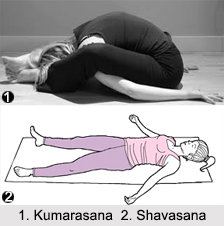 Cultural Asanas may be termed as daily physical exercise postures. The names of different cultural asana postures with their values have been mentioned in Classical Yoga Texts like "Gheranda Samhita", "Hatha Yoga Pradipika" and in a number of the "Yoga Upanishad". These Yoga Asanas are named as "Cultural Asanas" because of their central role in forming a comprehensive physical culture of exercise and general well being.
Cultural Asanas may be termed as daily physical exercise postures. The names of different cultural asana postures with their values have been mentioned in Classical Yoga Texts like "Gheranda Samhita", "Hatha Yoga Pradipika" and in a number of the "Yoga Upanishad". These Yoga Asanas are named as "Cultural Asanas" because of their central role in forming a comprehensive physical culture of exercise and general well being.
Types of Cultural Asanas
Cultural Asanas are sub-divided into physical asanas and relaxative asanas. Physical Asanas greatly assist in rendering the body healthy, while Relaxative Asanas work on the Chitta (the understated aspect of consciousness) level, eliminating every physical and mental tension.
According to the postures, the Physical Cultural Asanas can be divided in 7 groups which are as follows -
•Dynamic Sequences, such as the "Surya Namaskar"
•Backward Bending Postures, such as the cobra, locust or bow poses stretch the abdominal muscles, tone and strengthen the muscles that control the spine.
•Inverted Postures, such as the Sirsasana and Sarvangasana brings about better blood supply to the brain and ensure its health and the health of the cranial nerves serving the different organs of senses as well.
•Sideward Bending Postures, such as the triangle pose
•Forward Bending Postures, such as the Paschimottanasana loosen up the back, thus maintaining good health and increase vitality. During a forward bending asana, each of the vertebrae is stretched, the nerves are stirred, blood circulation around the spine is increased and the spinal cord is nourished.
•Twisting Postures, such as the half spinal twist which nourishes the organs such as the pancreas, stomach, kidneys, small intestines, liver and gall bladder, and relieve the disorders associated with these organs.
•Standing Postures including balancing poses, such as the tree pose improve the function of cerebellum, the brain centre that controls bodily movements. 
Relaxative Cultural Asanas are practiced in a supine position. Shavasana and Makarasana are the two foremost Relaxative asanas.
Phases of Cultural Asanas
There are three important phases while practicing cultural asanas: the phases include getting into the position, holding the position and getting out of the position. Each of the phases requires a considerable amount of time and should never be done in a hurry that may result in negative effects.
Effects of Cultural Asanas
The cultural asanas are primarily meant for culturing the body and mind. They are mainly aimed at fashioning a comprehensive physical culture and thus maintain the health of the body. The organs of human body are made up of tissues and the health of the body depends on the health of the tissues. The circulatory system can be kept in the best condition through cultural postures, which guarantee a steady supply of proper nourishment and of the internal secretions of the endocrine glands and elements necessary for nourishment of tissues.
Most of the Cultural asanas work on the abdominal part of the body. Cultural asanas require static stretching, which brings about an appropriate toning of muscles. They aid in bringing flexibility of the spine and render the back and spinal muscles stronger. Cultural asanas also enable the proper working of the vital organs in the thoracic and abdominal cavities.
The smooth functioning of the digestive system requires the gentle and automatic massage of the digestive organs that is provided by these kinds of asanas. Cultural postures like Bhujangasana, Salabhasana and Ardha Matsyendrasana keep the abdominal organs in good health and enable efficient removal of waste products. Cultural asanas are excellent for keeping the spine healthy and preserve the health of the nerves. They also increase mental power, concentration and the capacity to sustain large workloads without strain.
Cultural Asanas were developed from a small body of meditative postures, and converted into a comprehensive system of physical culture. Most of the asanas are cultural asanas, and their various beneficial effects on the body have made them a vital part of yogic practice. It is from this foundation of physical and mental well being that the higher challenges in Yoga are assayed.




















